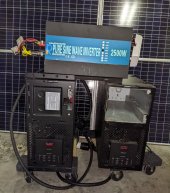I am wiring up a breaker box for an off grid cabin. No grid power of any sort on the property at all.
Do I bond neutral and ground in the breaker box? The ground will be wired to an 8' copper rod outside. I read some other posts and they said adding a generator complicates things, weather the generator also bonds ground and neutral or not. Also weather the inverter bonds neutral and ground or not. There will be a transfer switch to change from solar to generator power.
I watched a video where the reliable inverter popped the internal fuses because the neutral and ground where bonded.
How do I check to see if the generator, and or the inverter are bonded?
The generator is a predator 4550 inverter style, and the dc to ac inverter is a 3000 watt 24v reliable.
Do I bond neutral and ground in the breaker box? The ground will be wired to an 8' copper rod outside. I read some other posts and they said adding a generator complicates things, weather the generator also bonds ground and neutral or not. Also weather the inverter bonds neutral and ground or not. There will be a transfer switch to change from solar to generator power.
I watched a video where the reliable inverter popped the internal fuses because the neutral and ground where bonded.
How do I check to see if the generator, and or the inverter are bonded?
The generator is a predator 4550 inverter style, and the dc to ac inverter is a 3000 watt 24v reliable.
Last edited:



